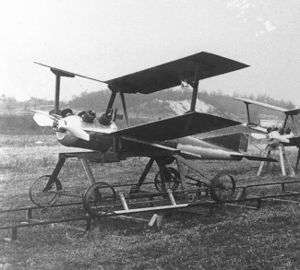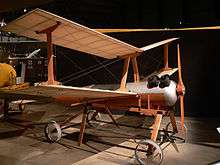Kettering Bug
| Bug | |
|---|---|
 | |
| Role | Missile |
| National origin | United States |
| Manufacturer | Dayton-Wright |
| Designer | Charles Kettering |
| First flight | October 2, 1918 |
|
| |
The Kettering Bug was an experimental, unmanned aerial torpedo, a forerunner of present-day cruise missiles. It was capable of striking ground targets up to 121 kilometres (75 mi) from its launch point, while traveling at speeds of 80 kilometres per hour (50 mph).[1]
Development
During World War I, the United States Army aircraft board asked Charles Kettering of Dayton, Ohio to design an unmanned "flying bomb" which could hit a target at a range of 64 kilometres (40 mi). Kettering's design, formally called the Kettering Aerial Torpedo but later known as the Kettering Bug, was built by the Dayton-Wright Airplane Company. Orville Wright acted as an aeronautical consultant on the project, while Elmer Ambrose Sperry designed the control and guidance system. A piloted development aircraft was built as the Dayton-Wright Bug.
The aircraft was powered by one 4-cylinder, 40-horsepower De Palma engine. The engine was mass-produced by the Ford Motor Company for about $40 each.[2] The fuselage was constructed of wood laminates and papier-mâché, while the wings were made of cardboard. The "Bug" could fly at a speed of 80 kilometres per hour (50 mph). The total cost of each Bug was $400.[1]
The Bug was launched using a dolly-and-track system, similar to the method used by the Wright Brothers when they made their first powered flights in 1903. Once launched, a small onboard gyroscope guided the aircraft to its destination. The control system used a pneumatic/vacuum system, an electric system and an aneroid barometer/altimeter.
To ensure the Bug hit its target, a mechanical system was devised that would track the aircraft's distance flown. Before takeoff, technicians determined the distance to be traveled relative to the air, taking into account wind speed and direction along the flight path. This was used to calculate the total number of engine revolutions needed for the Bug to reach its destination. When a total revolution counter reached this value a cam dropped down which shut off the engine and retracted the bolts attaching the wings, which fell off. The Bug began a ballistic trajectory into the target; the impact detonated the payload of 82 kilograms (180 lb) of explosives.
Flight test

The prototype Bug was completed and delivered to the Aviation Section of the U.S. Army Signal Corps in 1918, near the end of World War I. The first flight on October 2, 1918[3] was a failure: the plane climbed too steeply after takeoff, stalled and crashed.[4] Subsequent flights were successful, and the aircraft was demonstrated to Army personnel at Dayton.
"The Kettering Bug had 2 successes on 6 attempts at Dayton, 1 of 4 at Amityville, and 4 of 14 at Carlstrom."[5]
Despite some successes during initial testing, the "Bug" was never used in combat. Officials worried about their reliability when carrying explosives over Allied troops.[1] By the time the War ended about 45 Bugs had been produced. The aircraft and its technology remained a secret until World War II.
During the 1920s, what had become the U.S. Army Air Service continued to experiment with the aircraft until funding was withdrawn.
From April 1917 to March 1920 the US Government spent about $275,000 on the Kettering Bug.[6]
Survivors

A full-size reproduction of a Bug is on permanent display at the National Museum of the United States Air Force in Dayton, Ohio. It was constructed by Museum staff members, and went on display in 1964.[7]
Specifications (Bug)
Data from Kettering Aerial Torpedo “Bug” – National Museum of the United States Air Force
General characteristics
- Payload: 82 kg warhead (180 lb)
- Length: 3.8 m (12 ft 6 in)
- Wingspan: 4.5 m (15 ft)
- Height: 2.3 m (7.7 ft)
- Loaded weight: 240 kg (530 lb)
- Powerplant: 1 × V-4 piston engine, 30 kW (40 hp)
Performance
- Cruise speed: 80 km/h (50 mph)
- Range: 121 km (75 mi)
See also
References
- 1 2 3 Cornelisse, Diana G. Splendid Vision, Unswerving Purpose: Developing Air Power for the United States Air Force During the First Century of Powered Flight. Wright-Patterson Air Force Base, Ohio: U.S. Air Force Publications, 2002. ISBN 0-16-067599-5.
- ↑ Glines, C.V., "Ford's Forgotten Aviation Legacy", Aviation History (May 2008)
- ↑ NASA timeline
- ↑ Remote Piloted Aerial Vehicles : The 'Aerial Target' and 'Aerial Torpedo' in the USA
- ↑ The Evolution of the Cruise Missile by Werrell, Kenneth P. - See pdf pages 23–28
- ↑ Werrell, pdf page 28
- ↑ Kettering Aerial Torpedo “Bug” – National Museum of the United States Air Force
External links
- Encyclopedia of Astrobiology, Astronomy, and Space Flight: Kettering Bug
- Monash University information
